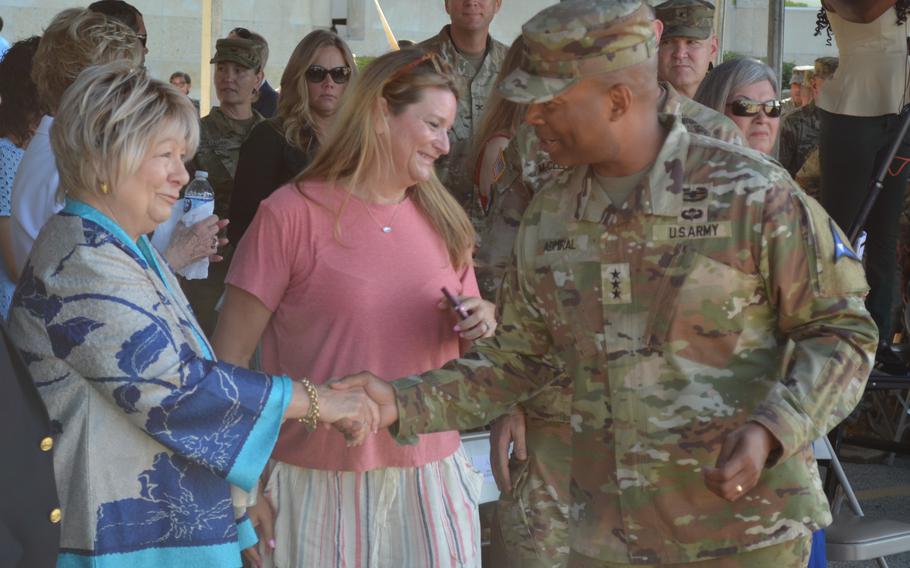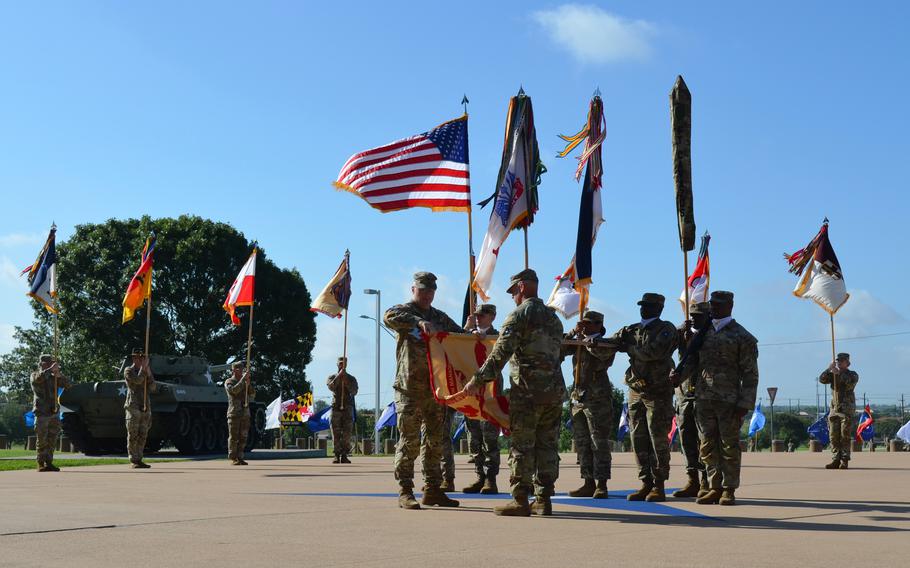
A portrait of Col. Robert B. Hood is displayed during a ceremony July 28, 2025, to rename an Army base in Killeen, Texas, in his honor. (Rose L. Thayer/Stars and Stripes)
FORT HOOD, Texas — The Army post in Killeen reverted to the name Fort Hood in a brief ceremony Monday morning, ending a two-year stint as Fort Cavazos.
Col. Mark McClellan and Command Sgt. Maj. Loyd Rhoades, the commander and senior noncommissioned officer of the base’s garrison command, carefully rolled up a flag bearing the name Cavazos and covered it in a long, slender bag. Then, the team unfurled the familiar flag of Fort Hood, which took its place alongside the American flag in a color guard formation outside of III Corps Headquarters.
Mitzi Huffman, a former Air Force captain, sat in the front row of the ceremony, occasionally wiping a tear from her face as the base was officially redesignated to honor her father, Col. Robert B. Hood, a veteran of World War I and recipient of the Distinguished Service Cross.
“In many ways, Col. Hood represents the ideal citizen soldier, a man who rose to the occasion when his nation needed him most and continued to give back long after the fighting had ceased,” Lt. Gen. Kevin Admiral, commander of III Corps and Fort Hood, said in a brief speech to mark the occasion. “In recognition of his service, Col. Hood’s name will live on as generations of soldiers who’ve served and will serve here learn about his career and the impact he had on our Army.”
The three-star general stood at a podium alongside a large, framed portrait of Hood, who died at age 73 in 1964, three years after his retirement from the Army.

Lt. Gen. Kevin Admiral, commander of III Corps and Fort Hood, shakes hands with Mitzi Huffman following a ceremony July 28, 2025, to mark the renaming of the Texas Army base to honor Huffman’s father, Col. Robert B. Hood. (Rose L. Thayer/Stars and Stripes)
Huffman, who did not speak at the ceremony, said in a statement released by Fort Hood that much of her father’s life was in selfless service to his country and his family.
“I tell you true, my dad would say the name on that gate does not ever define what that fort’s legacy is,” she said. “That fort is the backbone of the Army, and the Army code is instilled in every soldier that passes through that gate.”
Monday’s ceremony returned the name Hood to the base after President Donald Trump announced last month that all nine Army bases renamed to remove homage to Confederate-linked generals would return. However, federal law now bars the use of those Confederate names, so each of the bases has returned to their original name but to honor a different person.
When established in 1942, then Camp Hood was named to honor John Bell Hood, who led a Texas unit against Union forces in the Civil War. Today, the 280,000-acre post is home to roughly 38,000 service members.
A ceremony in the very same location two years ago removed that name and the base came to honor Gen. Richard Cavazos, a Texan, former III Corps commander and Medal of Honor recipient. For the two years it bore his name, it was the only Army base named for a Hispanic American.
Officials at the Texas post began using Fort Hood again immediately after Trump made the announcement, and many signs online and throughout the base have already been updated.
Admiral used his remarks Monday to describe Hood’s rise from Wellington, Kan., to become a decorated Army officer. Hood commissioned into the Army in August 1917, less than a year before III Corps was established, and soon became one of the first to serve in what is known as the “Phantom Corps.”

Col. Mark McClellan and Command Sgt. Maj. Loyd Rhoades, commander and senior noncommissioned officer of the garrison command at Fort Hood, Texas, uncase the base’s new flag during a ceremony to rename the base to honor Col. Robert B. Hood, on July 28, 2025. (Rose L. Thayer/Stars and Stripes)
He deployed to France with Echo Battery of the 12th Field Artillery Regiment of the 2nd Infantry Division, and on Sept. 12, 1918, then Capt. Hood directed his battery while under enemy fire at Thiaucourt, France, displaying exceptional leadership and bravery on the battlefield.
After losing his initial gun crews to German artillery and machine-gun fire, Hood reorganized his unit and restored its combat capability, which earned him the nation’s second-highest military honor, the Distinguished Service Cross.
“Col. Robert B. Hood’s life reminds us that while not every hero becomes a household name, their legacy can be immortalized through the values they lived and the lives that they touched,” Admiral said. “As we reflect on his contributions, we honor a leader who exemplified the very best of American military tradition.”